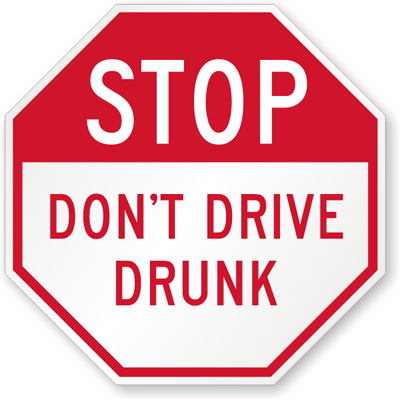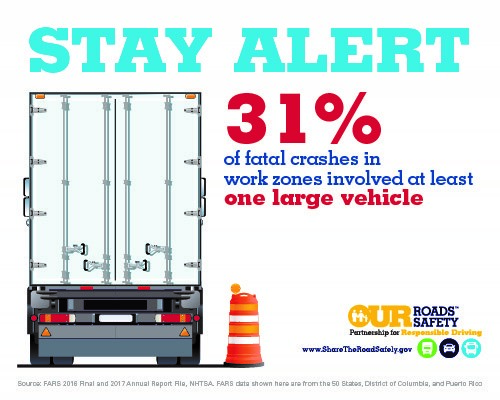How many times while driving have you seen another motorist and ask yourself…Is that a Drunk Driver?
The National Highway Traffic Safety Administration (NHTSA) has established four categories to identify if a person is operating a vehicle under the influence. Please review these categories to be a better defensive driver when these folks are operating around you.
1. Problems in maintaining lane position. Look for signs of erratic steering or an inability to keep the vehicle in a lane. Weaving across lanes, straddling two lanes, almost striking another vehicle are potential indicators of a drunk driver.
2. Speed and braking problems: Braking smoothly becomes a difficult task for an impaired driver. Look for general problems with stopping, like jerkiness, stopping short or abruptly. Maintaining speed also becomes a challenge for drunk drivers, so look for drivers that accelerate and decelerate quickly also a look for the driver who is operating well below the posted limit.
3. Vigilance problems. This simply means that the driver is unable to pay attention to driving. An impaired driver might forget simple things that a normal driver would not, such as driving at night without headlights on, wrong way on a one way, or responding slowly to traffic signals.
4. Judgment problems. Alcohol can impair a driver’s judgment of what is safe and what is not. Drunk drivers will often take risks that endanger other lives as well as their own. Examples of this is following another vehicle too closely or making unsafe lane changes. Any erratic behavior like making sudden, erratic turns, crossing the median, or violating no-turn laws can signal an impaired driver.
What should you do?
Seeing any of these identifying factors, you should prepare to take evasive action to avoid trouble or any unpredictable move that the suspected drunk driver might take. If you see two or more of the above factors, the driver is probably drunk, and it’s your responsibility to save the lives of other drivers and call the police immediately.
We are still in road construction season!
Drivers need to be especially cautious of construction zones. States are making a concentrated effort to raise the awareness of the dangers in these zones. Here are some safety tips you can share with your drivers regarding construction zones:
• Slow down and be alert when approaching a “construction zone.” Get into the correct lane well in advance. Where traffic is merging into a single lane, be cautious of other motorists racing to get ahead of slowing traffic.
• Get off the phone…. even Hands-Free phones are distracting your ability to safely operate your truck
• Pat attention to what those orange and black warning signs are telling you to do.
• Be alert for the actions of other drivers.
• Pay close attention to construction equipment and workers. You never know their next move, so be prepared to stop.
• Watch speed limits and don’t tailgate. Double your following distance. Rear-end collisions are the most common kind of construction zone accident.
• Watch for construction vehicles entering and exiting the road in or near the construction area, as they may enter and exit at a slower speed than other traffic.
• Turn your headlights on as you approach a work-zone, alerting both the construction workers and other traffic around you of your presence.
• Give construction workers a brake
Are your drivers traveling on these Dangerous Roads?
Two weeks ago, I was at a meeting in Orlando and traveled on I4 across Florida to our Idealease location in Tampa. Little did I know, I was traveling on the most dangerous stretch of highway in the United States. A lot has changed over the past four years. One thing that hasn’t is that Interstate 4, which connects Tampa and Daytona Beach, Florida, is still the deadliest highway in the U.S. This 132.2 miles of divided highway is the only interstate that averaged more than one death per mile from 2016 to 2019, according to the latest data compiled by Teletrac Navman, a fleet management software provider. The transportation technology company recently updated its popular 2017 infographic of the 25 deadliest highways across the country. the list and infographic are a good reminder for all drivers—both professional commercial drivers and passenger car drivers—to be aware and cautious on the road.
Commercial Vehicle Safety Alliance (CVSA) clarifies which documents can be presented electronically
The Commercial Vehicle Safety Alliance (CVSA) has released guidance clarifying the use of specific electronic documents in lieu of paper copies during roadside inspections. The purpose of the guidance is to clarify to drivers, motor carriers, and officers which documents can be provided electronically during a CVSA roadside inspection, and which are still required to be available as paper copies.
Which documents are included in the guidance?
Almost all the documents that the Federal Motor Carrier Safety Regulations (FMCSRs) require in 49 CFR parts 300-399 can be stored electronically. Exceptions to the rule are driver’s licenses and hazmat shipping papers, which are required to be available as hard copies. The bulletin noted that carriers transporting dangerous goods in Canada may be able to use electronic shipping papers if an equivalent level of safety is maintained and an equivalency certificate is obtained from Transport Canada. Examples of electronic records that fit within the scope of CVSA’s bulletin include hours-of-service documents, medical cards, medical waivers/exemptions, shipping documents (non-hazardous materials), lease agreements, and daily vehicle inspection reports. The annual vehicle inspection report may be electronic, but inspection stickers (when used) must continue to be affixed to vehicles and trailers.
What documents are not covered in the guidance?
Documents that are not covered, such as those relating to registration, fuel tax, insurance, over-dimensional permits, and Canadian daily vehicle inspections, may be accepted in electronic format. However, it is dependent upon state, local, provincial, and territorial laws, and regulations. Drivers and motor carriers must check with the appropriate authorities to confirm which format is acceptable prior to traveling through the jurisdiction(s).
Note that electronic documents, like paper documents, must be complete, accurate, legible, and signed, if a signature is required.










